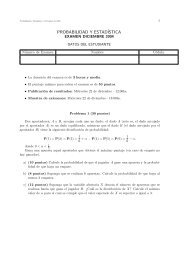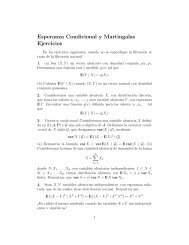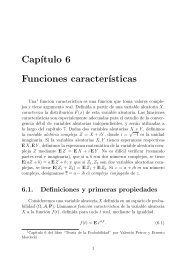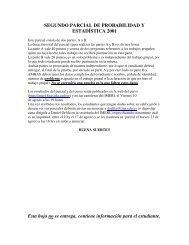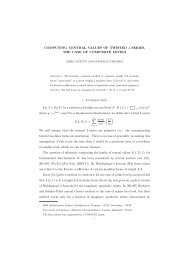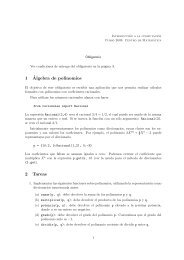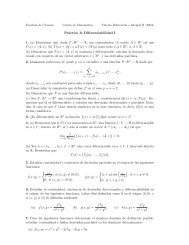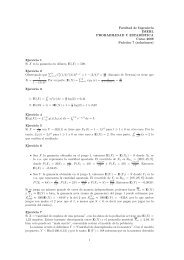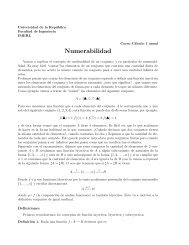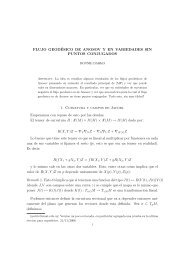El Laplaciano en Variedades Riemannianas - Centro de Matemática
El Laplaciano en Variedades Riemannianas - Centro de Matemática
El Laplaciano en Variedades Riemannianas - Centro de Matemática
Create successful ePaper yourself
Turn your PDF publications into a flip-book with our unique Google optimized e-Paper software.
4.2 <strong>El</strong> <strong>Laplaciano</strong> <strong>en</strong> la esfera S nProposición 4.7Consi<strong>de</strong>ramos la esfera (S n , g 0 ) d<strong>en</strong>tro <strong>de</strong> (R n+1 , g 0 ), si<strong>en</strong>do g 0 la métricaEuclí<strong>de</strong>a <strong>de</strong> R n+1 , y para el caso <strong>de</strong> la esfera la métrica heredada. Entonces, sif : R n+1 −→ R es una función <strong>de</strong> clase C ∞ se verifica que∣(∆ Rn+1 f)| S n = ∆ Sn (f| S n) − ∂2 f ∣∣∣S− n ∂f∂r 2 n ∂r ∣S nDemostración:Sea x 0 ∈ S n y consi<strong>de</strong>remos x 1 , ..., x n tal que el conjunto {x o , x 1 , ..., x n } esuna base ortonormal <strong>de</strong> R n+1 . A su vez, el conjunto {x 1 , ..., x n } es una baseortonormal <strong>de</strong> T x0 M. Consi<strong>de</strong>remos, ∀i ∈ {1, ..., n}, las geodésicas <strong>de</strong> la esferaque pasan por x 0 con velocidad x i , es <strong>de</strong>cirγ i (t) = cos t · x 0 + sin t · x id 2 (f ◦ γ i )(t) = − cos t ∂f (γdt 2i (0)) − sin t ∂2 f∂x 0por lo queLuego∆ Sn (f| S n)(x 0 ) = −−∂x 2 0d 2 (f ◦ γ i )(0) = − ∂f (xdt 20 ) + ∂2 f∂x 0= −n∑i=0n∑i=0∂ 2 (f ◦ γ i )(0) = −dt 2(γ i (0))sin t ∂f (γ i (0)) + cos t ∂2 f(γ i (0))∂x in∑i=0∂ 2 f(x∂x 2 0 ) + n ∂f (x 0 )i ∂x 0∂x 2 i(x 0 )Sabemos que el <strong>Laplaciano</strong> usual <strong>en</strong> R n+1 vi<strong>en</strong>e dado por(∆ Rn+1 f)(x) = −n∑i=0∂ 2 f(x) = −∂x 2 in∑i=1∂x 2 i[ ∂ 2 f+ (x∂x 2 0 ) − ∂f ](x 0 )i ∂x 0∂ 2 f∂x 2 i(x) + ∂2 f(x)∂x 2 0por lo tanto la restricción vi<strong>en</strong>e dada por la misma fórmula y t<strong>en</strong>emos que55(∆ Rn+1 f)| S n(x 0 ) = −n∑i=1∂ 2 f∂x 2 i(x 0 ) + ∂2 f(x∂x 2 0 )0= ∆ Sn (f| S n)(x 0 ) − n ∂f (x 0 ) − ∂2 f(x 0 )∂x 0∂x 2 0



